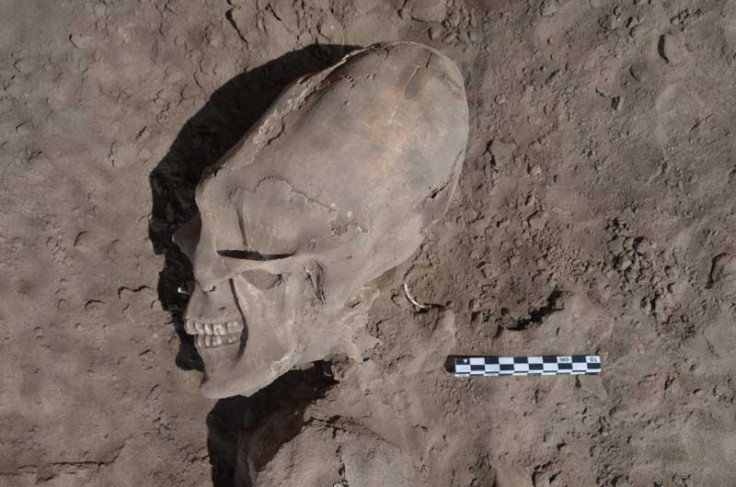'Alien-Like' Skulls Unearthed In Mexican Burial Site [PHOTO]

Archaeologists have discovered a Mexican burial site containing 25 human bodies. Of the human remains, 13 had intentionally deformed “alien-like” skulls while five skulls had dental mutilations.
The research team, led by Cristina Garcia, of Arizona State University, were excavating a 1,000 year old burial site in Northern Mexico, known as “El Cementario,” Live Science said. Intentional skull deformations, leading to alien-like skulls, were a common practice in Central America as well as western Mexico. The skulls were found in Onavas, a village in the Mexican state of Sonora, which borders Arizona and New Mexico.
The discovery of the alien-like skulls so far north has led archaeologists to re-evaluate how widespread was the practice of intentional skull deformation. The burial site in Onavas was discovered by residents in 1999, and it is the first pre-Hispanic site discovered in Sonora, the Live Science article said.
The skulls of interest are the 13 deformed ones that were elongated, causing the facial features to stretch, and the top of the skull to become pointed, giving it an alien-like appearance. The skulls were intentionally deformed during childhood, where pressure, due to binding, caused the skull to elongate, noted Live Science. Dental mutilations included teeth filing and teeth shaping.
Garcia told Live Science that the practice of skull deformation was “used by different societies in the world as a ritual practice, or for distinction of status within a group or to distinguish between social groups.” The bodies were not accompanied by ceremonial offerings, but some were adorned with bracelets, nose rings, earrings, shell bead necklaces and others with ornaments made from snails native to the Gulf of California. One person was buried with a turtle shell, according to a statement released by the National Archaeology Institute of Anthropology and History in Mexico.
Speaking of the discovery, Garcia said researchers have not, “been able to determine why some wore ornaments and others not, or why of the 25 skeletons only one was female.” Of the 25 human remains discovered, 17 were children, between the ages of five months and 16. The researchers said that they believe, due to the number of children, the cause of death was from poor execution of the cranial deformation practice, leading to too much pressure being applied to the skull. and ultimately, causing death, Garcia told Live Science.
The nearest archaeological site in Sonora is El Playa, located in the northern part of the Mexican state. Garcia said that archaeologists have discovered 400 bodies at El Playa, although that site was not intended as a burial site, unlike El Cementario.
Garcia said he plans to publishing the findings in a peer-reviewed journal. The team of archaeologists also plan on returning to the burial site, to map out the total size of El Cementario. Garcia said he hopes the discovery of El Cementario will lead to more surveys conducted in southwestern Sonora.
© Copyright IBTimes 2024. All rights reserved.






















